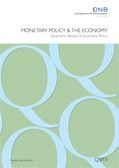Monetary Policy and the Economy Q4/23
25 years of EMU in Austria OeNB
OeNB
- published:
- April 2024
 OeNB
OeNB
25 years of EU Economic and Monetary Union in Austria: a macroeconomic assessment (PDF, 1.2 MB) Ragacs, Vondra. This article reviews the macroeconomic developments of 25 years living with the euro. At the time Austria adopted the euro, it had one of the highest GDP per head ratios in the euro area. Since then, it was able to maintain its above average position. This comes as a result of both GDP and population growth development being above the euro area average. During the last 25 years, except for the last two years, the inflation rate in Austria stood at 1.8% on average. This is in line with the price stability target of the European Central Bank (ECB) for the euro area. In this paper, we look at key macro variables of the Austrian economy and provide a comprehensive overview on empirical studies trying to assess the GDP and inflation effects of the Single European Market and the introduction of the euro on Austria. Most of these studies find significant, positive growth effects in the short term. en Economic and monetary union, euro, European integration, growth effects E6, F4, N13 Apr 12, 2024, 12:00:00 AM
The pass-through of policy interest rates to bank retail rates in Austria (PDF, 1.7 MB) Ferstl, Graf, Kwapil. The 25th anniversary of the European monetary union provides an excellent opportunity to examine whether the pass-through of monetary policy has changed over time. The interest rate channel of monetary policy – i.e. the transmission of policy rates to money market rates and ultimately to bank retail deposit and lending rates – is crucial to the functioning of monetary policy. Only if this channel works properly can monetary policy rates influence investment and saving decisions of households and businesses, thereby steering inflation. We provide an empirical analysis of the pass-through in Austria and the euro area, examining the speed of the transmission process, alongside short-term (a)symmetries and long-term passthrough coefficients. In line with the previous literature, our findings suggest that the long-term pass-through is nearly complete for bank lending and time deposit rates in Austria. Moreover, we provide evidence of an asymmetric pass-through to (overnight and time) deposit rates in Austria, with decreases in money market rates being propagated more quickly than increases. Overnight deposit rates not only show a significantly more sluggish pass-through process than other retail rates, but also an incomplete long-term pass-through coefficient. Moreover, all Austrian retail rates adjust more quickly to changes in money market rates than their respective counterparts in the euro area aggregate. Finally, we find a long-term stable relationship between money market and retail interest rates, indicating that the pass-through process in Austria has not significantly changed over time. en Monetary policy, Interest rate pass-through E52, E58 Apr 12, 2024, 12:00:00 AM
Exporting stability to the European neighborhood – the role of deposit euroization in CESEE revisited after 25 years of EMU (PDF, 1.1 MB) Scheiber, Wörz. We review the prevalence of deposit euroization in ten Central, Eastern and Southeastern European (CESEE) economies since the inception of the euro area, using both macro and micro data. Specifically, we calculate the ratio of foreign currency deposits to total resident non-MFI deposits for households and nonfinancial corporates, and we build on findings from the OeNB Euro Survey. The macro data confirm that the relevance of deposit euroization continues to differ strongly across countries. The levels of deposit euroization are lowest in the inflation-targeting economies of Czechia, Hungary and Poland, while high and persistent levels of deposit euroization are observed in the Western Balkan economies of Albania, Bosnia and Herzegovina, North Macedonia and Serbia. Our micro evidence broadly confirms the macro picture, yet it further suggests that euro deposits are rather unequally distributed across the population and likely to be held more often by more affluent individuals. en deposit euroization, household savings, survey data, CESEE D14, E41, G21 Apr 12, 2024, 12:00:00 AM
25 years of the OeNB in the Eurosystem – tracing the evolution of Governing Council governance (PDF, 528 kB) Ettl, Roitner. This paper deals with the role of national central banks (NCBs), especially the Oesterreichische Nationalbank (OeNB), since the establishment of the European System of Central Banks (ESCB) and the Eurosystem 25 years ago. It draws on the experiences and perceptions of past and present OeNB governors and a former European Central Bank (ECB) Executive Board member with whom we conducted semistructured in-depth interviews in September and October 2023. After outlining the special setup of the Eurosystem, we investigate the question whether the decision-making process has changed over the last 25 years and what factors played a role. This relates to formal changes like the implementation of the rotation scheme of voting rights, and to the impact of economic conditions and of the presidents of the ECB. Attention is also given to the level of decentralization within the ESCB/Eurosystem and the working methods established to enhance cooperation and collaboration. We conclude by describing what the OeNB, a rather small NCB, has learned since joining the Eurosystem. This can be summarized as follows: the size of a central bank matters, personal contacts and networking are essential, collaboration needs strengthening and specialization can be an asset. en central bank, Eurosystem/ESCB E58 Apr 12, 2024, 12:00:00 AM